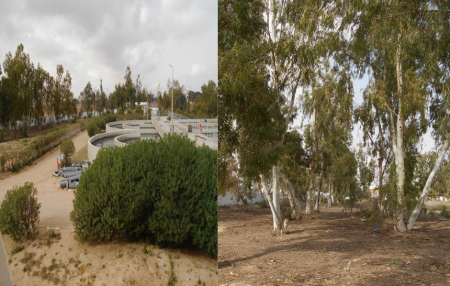
Objective:
The aim of this work was to evaluate the effect of treated wastewater short and long-term irrigation on essential oil composition from E. camaldulensis Dehn in order to detect allelopathic impacts on seed germination and seedling growth of Amaranthus hybridus L, Chenopodium album L, Echinochloa crus-galli (L) Beauv and Lolium perenne L as important weeds on many crops.
Context:
The agricultural system is exposed to several threats that can influence crop yields and sustainability such as diseases and pests especially weeds. Weeds take benefit of the advantageous state that occur in agriculture structure and present a good adaptability to different environment. Indiscriminate use of synthetic herbicides can cause serious ecological and environmental problems such as the degradation of soil resistance in weeds and amplify environmental pollution and health dangers
Contacts:
Ibtissem Taghouti
ibtissem.taghouti@gmail.com
Authors : Aya MAALOUL, Mercedes VERDEGUER SANCHO, Martina ODDO, Ezzeddine SAADAOUI, Naziha Ghazel, Chokri Ben Romdhane, Monia JEBRI, Serge MICHALET, Marie-Geneviève DIJOUX-FRANCA, Mohamed MARS, Mehrez ROMDHANE
Contact : maaloulaya@yahoo.fr
Further information:
Adams R (2007). Identification of essential oil components by Gas Chromatography/Mass Spectrometry. Allured Pu (4th ed). Illinois, USA.
Arminante F, De Falco E, De Feo V, De Martino L, Mancini E, Quaranta E (2006). Allelopathic activity of essential oils from Mediterranean Labiatae. Acta Horticulturae. https://doi.org/10.17660/ActaHortic.2006.723.47
Barbosa LCA, Filomeno CA, Teixeira RR (2016). Chemical Variability and Biological Activities of Eucalyptus spp . Essential Oils. Molecules. https://doi.org/10.20944/preprints201610.0009.
Batish DR, Singh HP, Kohli R K, Kaur S (2008). Eucalyptus essential oil as a natural pesticide. Forest Ecology and Management. https://doi.org/10.1016/j.foreco.2008.08.008
Batish DR, Singh HP, Setia N, Kaur S (2006). Chemical Composition and Phytotoxicity of Volatile Essential Oil from Intact and Fallen Leaves of Eucalyptus citriodora. Phytotoxicity of Eucalyptus Leaf Oil and Major Constituents 61: 465-471.
Bedbabis S, Ferrara G, Ben Rouina B, Boukhris M (2010). Effects of irrigation with treated wastewater on olive tree growth, yield and leaf mineral elements at short term. Scientia Horticulturae. https://doi.org/10.1016/j.scienta.2010.07.020
Ben Ghnaya A, Hamrouni L, Amri I, Ahoues H, Hanana M, Romane A (2015). Study of allelopathic effects of Eucalyptus erythrocorys L. crude extracts against germination and seedling growth of weeds and wheat. Natural Product Research. https://doi.org/10.1080/14786419.2015.1108973
Ben Jemâa JM, Haouel S, Bouaziz M, Khouja ML (2012). Seasonal variations in chemical composition and fumigant activity of five Eucalyptus essential oils against three moth pests of stored dates in Tunisia. Journal of Stored Products Research. https://doi.org/10.1016/j.jspr.2011.10.001
Bernestein N, Chaimovitch D, Dudai N (2009). Effect of irrigation with secondary treated effluent on essential oil, antioxidant activity, and phenolic compounds in oregano and rosemary. Agronomy Journal 101: 1-10.
Cheng SS, Huang CG, Chen YJ, Yu JJ, Chen WJ, Chang ST (2009). Chemical compositions and larvicidal activities of leaf EOs from two Eucalyptus species. Bioresource Technology. https://doi.org/10.1016/j.biortech.2008.02.038
Del Moral R. and Muller CH (1970). The Allelopathic Effects of Eucalyptus camaldulensis. American Midland Naturalist 83(1): 254-282.
Einhellig FA (1996). Interactions involving allelopathy in cropping systems. Agronomy Journal. https://doi.org/10.2134/agronj1996.00021962003600060007x
Falk KL, Tokuhisa JG, Gershenzon J (2007). The effect of sulfur nutrition on plant glucosinolate content: Physiology and molecular mechanisms. Plant Biology. https://doi.org/10.1055/s-2007-965431
Farahat E, Linderholm, HW (2013). Effects of treated wastewater irrigation on size-structure, biochemical products and mineral content of native medicinal shrubs. Ecological Engineering. https://doi.org/10.1016/j.ecoleng.2013.07.050
Gershenzon, J (1984). Changes in the Levels of Plant Secondary Metabolites Under Water and Nutrient Stress. Phytochemical Adaptations to Stress 18: 273-320.
Khouja M.L, Khaldi A, Rejeb M (2000). Results of the Eucalyptus introduction trials in Tunisia. In International Conference on Eucalyptus in the Mediterranean Basin: Perspectives and New Utilization octobre 15-19 Taormina, Italy Centro Promozione e Pubblicità, Firenze pp 163-168.
Kong C, Hu F, Xu T, Lu Y (1999). Allelopathic potential and chemical constituents of volatile oil from Ageratum conyzoides. Journal of Chemical Ecology 25(10): 2347-2356
López ML, Bonzani NE, Zygadlo JA (2009). Allelopathic potential of Tagetes minuta terpenes by a chemical anatomical and phytotoxic approach. Biochemical Systematics Ecology 36: 882-890
Mahumane GD, Vuuren SF Van, Kamatou G, Sandasi M, Viljoen AM, Mahumane GD, Kamatou G (2016). Chemical composition and antimicrobial activity of Eucalyptus radiata leaf essential oil sampled over a year. Journal of Essential Oil Research. https://doi.org/10.1080/10412905.2016.1175386
Scrivanti LR, Zunino M P, Zygadlo JA (2003). Tagetes minuta and Schinus areira essential oils as allelopathic agents. Biochemical Systematics and Ecology 31: 563-572.
Silvestre AJD, Cavaleiro AS, Delmondb B, Filliatreb C, Bourgeois G (1997). Analysis of the variation of the essential oil composition of Eucalyptus globulus Labill . from Portugal using multivariate statistical analysis. Industrial Crops and Products 6: 27-33.
Stamp, N (2003). Out Of The Quagmire Of Plant Defense Hypotheses. The Quarterly Review of Biology. https://doi.org/10.1086/367580
Su YC, Ho CL, Wang EIC, Chang ST (2006). Antifungal activities and chemical compositions of essential oils from leaves of four eucalyptus. Taiwan J For Sci 1(9): 49-61.
Verdeguer M, Blázquez MA, Boira H (2009). Phytotoxic effects of Lantana camara, Eucalyptus camaldulensis and Eriocephalus africanus essential oils in weeds of Mediterranean summer crops. Biochemical Systematics and Ecology. https://doi.org/10.1016/j.bse.2009.06.003
Verdeguer M, García-Rellán D, Boira H, Pérez E, Gandolfo S, Blázquez MA (2011). Herbicidal activity of Peumus boldus and Drimys winterii essential oils from Chile. Molecules. https://doi.org/10.3390/molecules16010403
Vyvyan JR (2002). Allelochemicals as leads for new herbicides and agrochemicals. Tetrahedron. https://doi.org/10.1016/S0040-4020(02)00052-2
Weston LA (1996). Utilization of allelopathy for weed management in agroecosystems. Agronomy Journal. https://doi.org/10.2134/agronj1996.00021962003600060004x